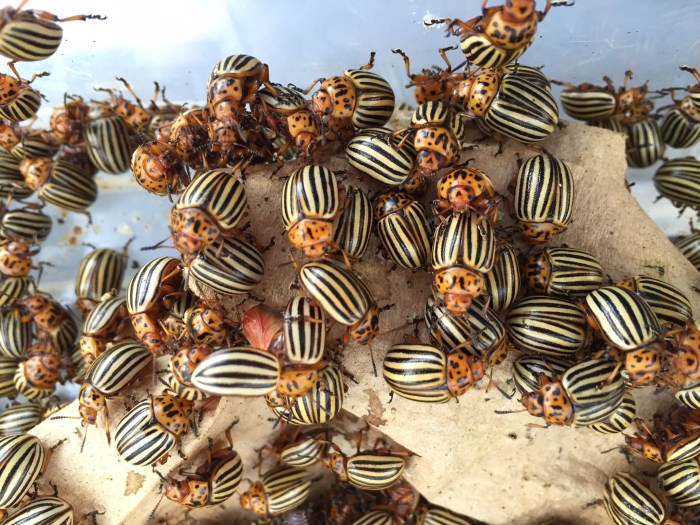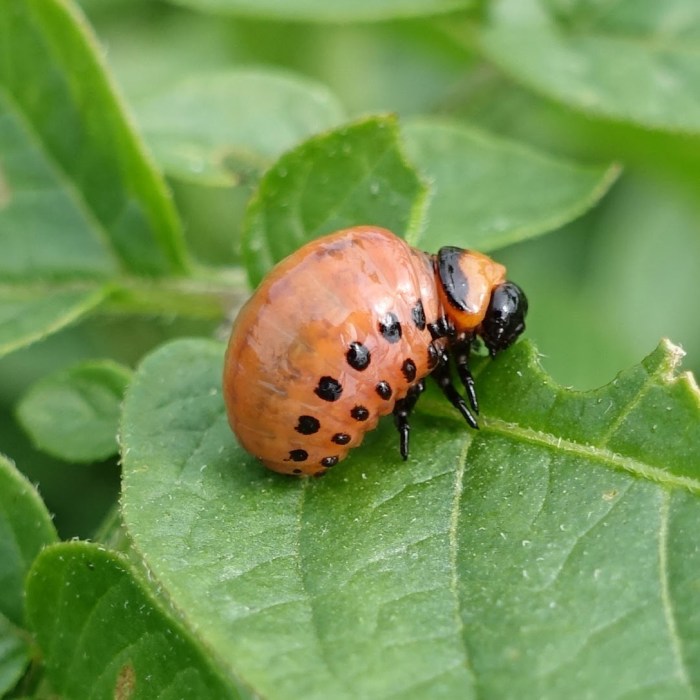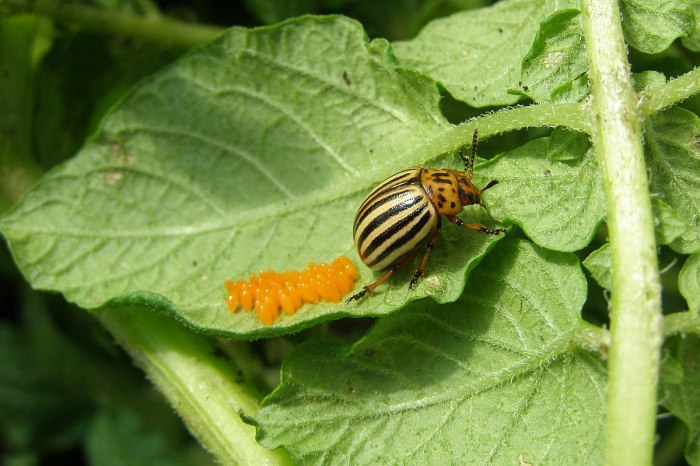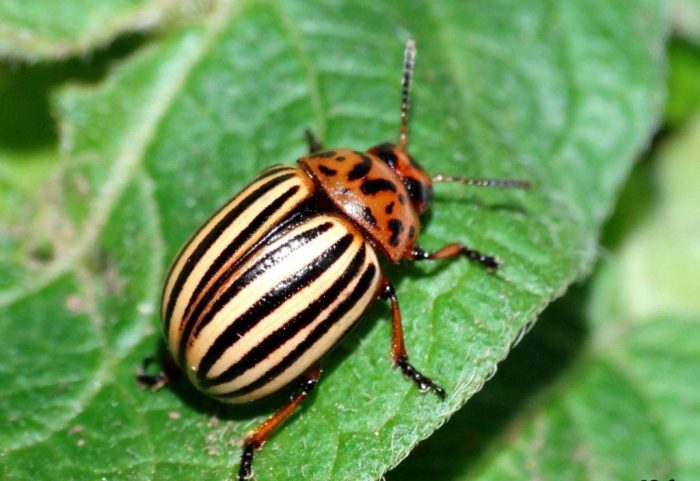Colorado potato beetles, a name synonymous with potato plant devastation, are notorious for their voracious appetite and relentless reproduction. These striped insects, with their distinctive orange and black markings, are a gardener’s worst nightmare, capable of decimating potato crops in a matter of days.
Their life cycle, a fascinating journey from egg to adult, is a testament to their adaptability and resilience, making them a persistent threat to potato production worldwide.
Their journey begins with tiny yellow eggs laid on the underside of potato leaves. These eggs hatch into larvae, voraciously feeding on foliage, leaving behind characteristic “skeletonized” leaves. After several molts, the larvae transform into pupae, hidden in the soil.
Finally, the adult beetles emerge, ready to mate and lay more eggs, perpetuating the cycle of destruction. This relentless life cycle, coupled with their resistance to many insecticides, has made Colorado potato beetles a formidable challenge for farmers and home gardeners alike.
Colorado Potato Beetle Damage

The Colorado potato beetle (CPB) is a serious pest of potato plants, and its infestation can cause significant damage to crops, leading to substantial economic losses. Understanding the signs and symptoms of a CPB infestation and the damage it inflicts is crucial for effective pest management.
Damage to Potato Plants
The Colorado potato beetle’s feeding habits have a detrimental impact on potato plants. Both adult beetles and larvae feed on potato leaves, stems, and even the tubers. The damage caused by these beetles can be substantial, leading to reduced yields and even complete crop failure.
Leaf Damage
- Skeletonization:Both adults and larvae feed on the leaves, leaving behind a network of veins. This is a characteristic sign of CPB infestation. The larvae, in particular, are voracious eaters and can quickly skeletonize entire leaves.
- Leaf Drop:Extensive feeding by CPB can lead to premature leaf drop, reducing the plant’s ability to photosynthesize and produce tubers.
- Stunted Growth:The loss of foliage due to CPB feeding can hinder the plant’s growth and development, resulting in smaller and fewer tubers.
Stem Damage
- Girdling:CPB larvae can girdle stems, cutting off the flow of nutrients and water to the plant’s upper parts. This can lead to wilting and eventual death of the plant.
Tuber Damage
- Direct Feeding:Although less common, CPB larvae can feed on exposed tubers, causing damage and making them unmarketable.
- Entry Points for Disease:Damage to the plant’s leaves and stems can create entry points for fungal and bacterial diseases, further impacting the crop’s health and yield.
Economic Impact, Colorado potato beetles
Colorado potato beetle infestations can have significant economic consequences for potato farmers. The damage caused by these beetles can lead to:
- Reduced Yields:Infestations can significantly reduce potato yields, impacting farmers’ income.
- Increased Costs:Farmers may need to invest in expensive pesticides and other control measures to manage CPB populations, adding to their production costs.
- Market Value Loss:Damaged tubers may be unmarketable or fetch lower prices, further impacting farmers’ profits.
- Crop Failure:In severe cases, CPB infestations can lead to complete crop failure, resulting in substantial financial losses for farmers.
The economic impact of Colorado potato beetle infestations on potato production can be substantial, ranging from reduced yields to complete crop failure, leading to significant financial losses for farmers.
Colorado Potato Beetle Control

Controlling Colorado potato beetles is crucial for protecting potato crops from significant damage. A combination of methods, including cultural practices, chemical interventions, and biological control, is often necessary for effective management.
Cultural Control Methods
Cultural control methods focus on manipulating the environment to make it less favorable for beetle development and survival. These methods are often the first line of defense and can be quite effective when implemented consistently.
- Crop Rotation:Rotating potato crops with non-host plants, such as corn, wheat, or alfalfa, can disrupt the beetle’s life cycle by preventing them from finding suitable food sources. This practice can significantly reduce beetle populations over time.
- Handpicking:Handpicking beetles and their larvae from plants, especially during early infestations, can help control small populations. This method is most effective on small plots or when the infestation is detected early. However, it becomes less practical for larger-scale farming.
- Tillage:Deep plowing after harvest can bury pupae and eggs, reducing their survival rate. This method is most effective in areas with suitable soil conditions and climate.
- Row Covers:Using row covers, especially floating row covers, can prevent beetles from accessing plants. This method is particularly useful for small-scale gardens or for protecting vulnerable young plants.
Insecticide Use
Insecticides can be an effective way to control Colorado potato beetle populations, especially when cultural methods alone are insufficient. However, their use should be carefully considered due to potential risks to the environment, beneficial insects, and human health.
Colorado potato beetles are notorious for their voracious appetites, decimating potato plants in a matter of days. While battling these pests, I also found myself facing a similar problem with alder leaf beetles munching on my prized trees. Luckily, I found a great resource on how to get rid of alder leaf beetles which helped me get rid of those pesky bugs too.
Now, I can focus my attention back on those Colorado potato beetles and find the best way to keep them from ruining my potato harvest.
- Pros:Insecticides can provide rapid and effective control of beetle populations, especially when applied at the right time and in the correct manner. They are particularly useful for large-scale farming operations where handpicking or other methods are not practical.
- Cons:Insecticides can have negative impacts on beneficial insects, such as pollinators and natural predators of the Colorado potato beetle. They can also pose risks to human health and the environment, particularly if used improperly or excessively. Moreover, repeated insecticide use can lead to insecticide resistance in beetle populations, making control more challenging over time.
Biological Control Agents
Biological control utilizes natural enemies of the Colorado potato beetle, such as parasitic wasps and predatory insects, to suppress their populations. This approach is often more environmentally friendly and sustainable than relying solely on chemical control.
- Parasitic Wasps:Several species of parasitic wasps, such as -Cotesia glomerata* and -Edovum puttleri*, lay their eggs inside Colorado potato beetle eggs or larvae. The wasp larvae then feed on the beetle eggs or larvae, killing them. This biological control method can be very effective in reducing beetle populations.
Colorado potato beetles are a familiar sight in gardens, munching their way through potato plants with gusto. While these pests are a nuisance for gardeners, they are a stark reminder of the delicate balance in nature. Just like the monarch butterfly migration , a complex journey driven by instinct and environmental cues, the Colorado potato beetle’s life cycle is intricately tied to the availability of its food source.
Understanding these natural cycles helps us appreciate the interconnectedness of our ecosystem and the importance of protecting both beneficial insects and the plants they rely on.
- Predatory Insects:Predatory insects, such as ladybugs, lacewings, and ground beetles, can also help control Colorado potato beetle populations by feeding on their eggs and larvae. Encouraging the presence of these beneficial insects through habitat management can contribute to natural pest control.
Colorado Potato Beetle Resistance

The Colorado potato beetle (CPB) has developed a remarkable ability to resist insecticides, posing a significant challenge to potato growers. This resistance stems from various mechanisms that allow the beetle to survive exposure to insecticides that would otherwise be lethal.
Understanding these mechanisms and the factors driving resistance is crucial for developing effective control strategies.
Mechanisms of Insecticide Resistance
Insecticide resistance in CPB arises from various mechanisms, including:
- Target-Site Resistance:This mechanism involves alterations in the target site of the insecticide within the beetle’s body. For instance, mutations in the acetylcholinesterase enzyme, the target of organophosphate and carbamate insecticides, can reduce the insecticide’s binding affinity, making the beetle less susceptible.
- Metabolic Resistance:CPB can develop increased levels of enzymes that break down or detoxify insecticides, rendering them less effective. These enzymes, such as glutathione S-transferases and cytochrome P450 monooxygenases, can accelerate the metabolism of insecticides, reducing their toxicity.
- Penetration Resistance:Some CPB populations have evolved mechanisms that reduce the penetration of insecticides into their bodies. This can involve changes in the cuticle, the outer layer of the beetle’s body, which acts as a barrier to insecticide entry.
- Behavioral Resistance:CPB may exhibit behavioral changes that minimize their exposure to insecticides. This can include avoiding treated areas, feeding on less-treated plants, or altering their feeding habits.
Factors Contributing to Insecticide Resistance
The development of insecticide resistance in CPB is influenced by several factors:
- Overuse and Misuse of Insecticides:Repeated and excessive use of the same insecticide class can select for resistant individuals, leading to a gradual increase in the resistance frequency within the population.
- Lack of Insecticide Rotation:Using the same insecticide repeatedly without rotating to different classes can accelerate the selection of resistant individuals.
- Refuge Areas:The presence of untreated areas, known as refuges, allows susceptible beetles to survive and reproduce, maintaining genetic diversity and slowing down the spread of resistance.
- Gene Flow:Resistant genes can spread through the population through mating between resistant and susceptible individuals, further contributing to the development of resistance.
- Natural Selection:The pressure of insecticides in the environment favors individuals with resistance traits, allowing them to survive and reproduce, leading to an increase in resistance frequency over time.
Strategies for Managing Insecticide Resistance
Managing insecticide resistance in CPB requires a multifaceted approach:
- Insecticide Rotation:Rotating insecticides from different chemical classes helps to prevent the selection of resistant individuals and slows down the development of resistance.
- Integrated Pest Management (IPM):IPM emphasizes a combination of cultural, biological, and chemical control methods to manage CPB populations. This approach aims to minimize insecticide use and reduce the selection pressure for resistance.
- Refuge Areas:Maintaining untreated areas within a potato field allows susceptible beetles to survive and reproduce, slowing down the spread of resistance.
- Monitoring and Resistance Testing:Regularly monitoring CPB populations for resistance to different insecticides is crucial for identifying resistance problems early and implementing appropriate control strategies.
- Development of New Insecticides:Research and development efforts are ongoing to develop new insecticides with novel modes of action that are less likely to lead to resistance.
Integrated Pest Management (IPM)

Integrated Pest Management (IPM) is a comprehensive approach to managing pest populations, including Colorado potato beetles, that emphasizes preventing pest outbreaks rather than solely relying on chemical control. This approach aims to minimize environmental impact and promote sustainable agriculture.
Principles of IPM for Colorado Potato Beetle Management
IPM for Colorado potato beetle management relies on several key principles. These principles promote a holistic approach to pest control, incorporating various methods to minimize reliance on chemical insecticides.
- Monitoring:Regular monitoring of potato plants for signs of Colorado potato beetle infestation is crucial. This involves inspecting plants for beetle presence, egg masses, and larval damage. Early detection allows for timely intervention and prevents populations from reaching damaging levels.
- Cultural Practices:Implementing cultural practices that discourage beetle infestations can significantly reduce their impact. These practices include planting resistant potato varieties, rotating crops, and maintaining good field hygiene. These methods disrupt beetle life cycles and create unfavorable conditions for their survival.
- Biological Control:Utilizing natural enemies, such as predatory insects and parasitic wasps, can effectively control Colorado potato beetle populations. These beneficial organisms feed on beetles and their larvae, helping to keep populations in check. Introducing these natural enemies into the ecosystem can significantly reduce the need for chemical insecticides.
- Chemical Control:While chemical insecticides should be used as a last resort, they can play a role in managing outbreaks. Choosing selective insecticides that target Colorado potato beetles while minimizing harm to beneficial organisms is crucial. Applying these insecticides strategically, targeting specific life stages, can maximize their effectiveness while minimizing environmental impact.
Designing an IPM Program
Designing an effective IPM program for Colorado potato beetle control involves a combination of different control methods, each playing a crucial role in minimizing pest populations.
- Monitoring:Regular monitoring is essential to track beetle populations and identify potential outbreaks. This can involve visual inspections, traps, and pheromone monitoring. Monitoring data helps determine the effectiveness of implemented control measures and allows for adjustments as needed.
- Cultural Practices:Implementing cultural practices can significantly reduce beetle pressure. These include planting resistant potato varieties, such as those with hairy leaves that deter beetles, and rotating crops to disrupt beetle life cycles. Maintaining good field hygiene, including removing crop debris and weeds, can further reduce beetle habitat and breeding sites.
- Biological Control:Introducing natural enemies, such as predatory insects and parasitic wasps, can provide effective biological control. These organisms feed on beetles and their larvae, reducing populations naturally. Conservation tillage practices can promote the presence of these beneficial organisms by providing habitat and food sources.
- Chemical Control:Chemical insecticides should be used as a last resort, only when necessary to prevent significant crop damage. Choosing selective insecticides that target Colorado potato beetles while minimizing harm to beneficial organisms is crucial. Applying these insecticides strategically, targeting specific life stages, can maximize their effectiveness while minimizing environmental impact.
Importance of Monitoring
Monitoring Colorado potato beetle populations is crucial for effective IPM. This allows for early detection of infestations, enabling timely intervention and preventing populations from reaching damaging levels. Monitoring data provides valuable insights into beetle population dynamics, helping to determine the effectiveness of implemented control measures and allowing for adjustments as needed.
Final Thoughts: Colorado Potato Beetles

Understanding the Colorado potato beetle’s life cycle, its feeding habits, and its resistance mechanisms is crucial for effective management. By implementing integrated pest management strategies, including crop rotation, handpicking, and biological control agents, we can minimize the impact of these destructive insects on our potato crops.
While the battle against Colorado potato beetles may seem daunting, with knowledge and proactive measures, we can ensure healthy and bountiful potato harvests for years to come.